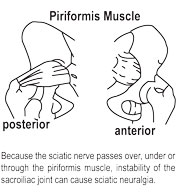For many years, i have helped literally hundreds of pregnant women with everything from breech presentations to carpal tunnel syndrome. I have encountered basically five common neurological complaints that frequent this part of our population. In my experience, chiropractic care is the best choice for each and every one of these conditions.
The five complaints defined are:
1. Meralgia Paresthetica: Compression of the lateral femoral cutaneous nerve as it passes beneath the inguinal ligament. Pain and paresthesias are seen in the lateral aspect of the upper thigh.
• During pregnancy: Meralgia Paresthetica is most likely due to the abdominal weight gain in pregnancy. (Compresses the inguinal ligament)
• Case management: L3 is almost always involved as are the trochanters. They almost always rotate anteriorly on the side of symptomotology. Tight belts and waistbands will exacerbate and even cause symptoms.

2. Sciatic neuralgia: Three mechanisms can cause inflammation of the sciatic nerve.
Vertebrogenic: Compression of the lumbarplexus from lumbar subluxation.
Myogenic: Spastic or flaccid piriformis muscle.
Discogenic: Bulging disc
• During pregnancy: Because the sciatic nerve passes over, under or through the piriformis muscle, instability of the sacroiliac joint can cause sciatic neuralgia. Various hormones of pregnancy often cause this instability and can lead to either a spastic or flaccid piriformis muscle which almost always irritates the sciatic nerve. The positioning of the fetus, itself, can also be a factor.
• Case Management: The best way to address sciatica is to first determine which of the causes you are dealing with. After uncovering that, your correction protocol is easy to discern based on the techniques you use in your office. Since every technique handles sciatic neuropathy in different ways, use the techniques you have already had success with when dealing with sciatica, making minor modifications as needed.
3. Headaches: As chiropractors, we know that the cause of many headaches, including tension, sinus, and some types of migraines, can be traced to subluxations in the cervical vertebrae.
• During pregnancy: Headaches are very common, especially in the first trimester, and are usually due to hormonal changes. High surges of estrogen cause migraine type headaches. If a woman has never experienced headaches on a regular basis before pregnancy, expect them to be related to hormones. A loss of cervical curve (as a result of lumbar hyperlordosis) can be a component as well.
• Case management: It is important to check L3/L4 and the sacrum when hormone headaches are suspected. If headaches are persistent after twenty-eight weeks of gestation, they could be related to pre-eclampsia or toxemia of pregnancy. Check for high blood pressure and swollen ankles. If these are present, recommend that the patient see her midwife or doctor immediately.
4. Carpal Tunnel Syndrome: Often caused by lower cervical subluxations. Also repetitive strain and overuse causes problems with the tensor retinaculum.
• During pregnancy: Symptoms appear as the pregnancy progresses. It is not uncommon for the extra retention of water to cause these symptoms.

• Case management: Check lower cervicals. Keep in mind that, if CTS is being caused by water retention, it should dissipate after childbirth. If it gets worse after childbirth, it’s most probably because of Nursing Mother’s Neck.™ Be sure to check the clavicles, shoulders, elbows and wrists for fixations.
5. Bell’s Palsy is defined in Taber’s Cylopedic Medical Dictionary, 16th Edition, as an idiopathic unilateral facial paralysis with sudden onset.
• During pregnancy: The following are presumed mechanisms that may cause Bell’s palsy:
a. Swelling of the facial nerve due to hormonal changes and increased fluid retention during pregnancy
b. Subluxation, especially in the atlanto-occipital region.
c. Subluxation of the TMJ. Note: Personally, I believe these instances can cause compression of the facial nerve as it passes through the temporal bone. • Case management: Most often, Bell’s palsy occurs in the 3rd trimester or post partum (more common in my experience) and responds very favorably to chiropractic adjustments. Be sure to check the TMJ, atlas, occiput and sacrum.
What can you do to help women with these conditions? Reassure mom that she’s not broken. Often, women have a misconception that there is something wrong. They may say, “My neighbor had nine kids and never had a problem like this.”
To this, I say, “Remember when you fell off a horse when you were eleven? That is why you are having the trouble you are having today. This problem has been there since your fall, you just never noticed it until your tummy started to grow and changed everything about your pelvis and lower back. Once the baby is born, you will start to feel a lot better, but we still have a lot of work to do get you back in shape for the next baby. HA, HA.”
Sometimes humor helps; sometimes you’ll get a dirty look. So, use your best judgment in each case. Most importantly, give your practice member hope that she’s found someone who can help her. Many times, you will be the last resort. Be sure she saved the best for last.
Dr. Karen (Gardner) Bagnell graduated from Life College in 1993. Drs. Karen and Lawrence Bagnell practice together in Newtown/Langhorne, Pennsylvania. They have two beautiful children. The birth of their son was featured on The Learning Channel “A Baby Story.” He was born at home, in a hot tub with the aide of his father’s chiropractic touch.
Drs. Bagnell have a family practice. Dr. Karen Bagnell focuses her attention on the special needs of a pregnant woman and her family and cares for patients at a local birth center on a weekly basis. She has recently been appointed Dean of Pregnancy care at www.chirocollege.com.For more information, visit www.pregnancychiropractic.com or e-mail [email protected].
